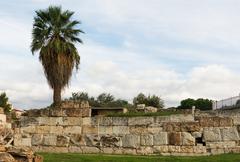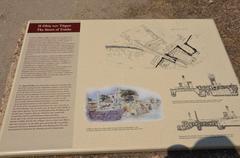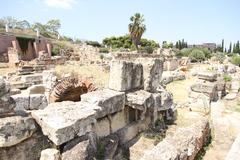
Visiting Kerameikos: Hours, Tickets, and Historical Insights in Athens
Date: 18/07/2024
Introduction
Kerameikos, one of Athens’ most significant archaeological sites, offers a profound connection to the ancient city’s history, culture, and traditions. Situated just outside the city walls, Kerameikos served as both a bustling hub for potters and ceramicists and, later, as the city’s official cemetery. This transformation from an artisan’s quarter to a sacred burial ground encapsulates the very essence of Athenian identity and societal values. The area’s name itself derives from the Greek word ‘keramos,’ meaning pottery, reflecting its early significance in the production and trade of ceramics across the Mediterranean (source).
The site’s history stretches back to the Mycenaean period (circa 1600-1100 BC), evolving through various phases of Athenian civilization. By the 6th century BC, under the reforms of statesman Solon, Kerameikos was designated as the city’s principal cemetery. This decision imbued the area with deep symbolic meaning, positioning it as a threshold between the realms of the living and the dead. The Sacred Way, a notable feature of Kerameikos, traversed this necropolis, linking it to the sanctuary of Demeter at Eleusis and playing a crucial role in religious festivals like the Panathenaic Procession (source).
Today, visitors to Kerameikos can explore its well-preserved ruins and monuments, such as the Dipylon Gate, the Pompeion, and the evocative Street of Tombs. These features offer invaluable insights into Athenian funerary practices, artistic achievements, and social hierarchies. The on-site museum further enriches the experience, housing a collection of artifacts that shed light on the daily lives and rituals of ancient Athenians (source).
This guide aims to provide comprehensive information for planning your visit to Kerameikos, including historical context, key attractions, practical tips, and visitor information. Whether you are an archaeology enthusiast or a casual traveler, Kerameikos promises a unique and unforgettable journey through time.
Table of Contents
- Introduction
- History of Kerameikos
- Key Attractions and Archaeological Findings
- Visitor Information
- Conclusion
History of Kerameikos
From Humble Beginnings to Sacred Ground
The story of Kerameikos begins long before its days as a cemetery. In the early Mycenaean period (circa 1600-1100 BC), the area served as a settlement outside the city walls, strategically positioned near the banks of the Eridanos River. This location, prone to flooding, contributed to the area’s unique soil composition, ideal for the production of pottery.
The Potter’s Legacy
By the 10th century BC, Kerameikos had become a bustling hub for potters and ceramicists, giving the area its name, derived from the Greek word “keramos,” meaning “pottery.” The craftsmanship of these artisans was highly sought after, with their distinctive Athenian pottery traded across the Mediterranean. The Kerameikos potters, through their artistry and trade, played a crucial role in shaping Athenian identity and spreading its cultural influence.
The Establishment of the Cemetery
The 6th century BC marked a turning point for Kerameikos. Under the reforms of the Athenian statesman Solon, the area was designated as the city’s official cemetery. This decision was not merely practical but deeply symbolic. Situated at the edge of the city, Kerameikos became a liminal space, a threshold between the worlds of the living and the dead.
The Sacred Way
The cemetery was traversed by the Sacred Way, a road of immense historical and cultural significance. This ancient path, leading from the city center to the sanctuary of Demeter at Eleusis, became the route for the Panathenaic Procession, a grand religious festival held in honor of Athena, the patron goddess of Athens. The procession, a vibrant display of Athenian piety and power, would pass through Kerameikos, connecting the living with their ancestors and reinforcing the city’s shared identity.
Monuments of Mourning
Over the centuries, Kerameikos evolved into a sprawling necropolis, reflecting the social and artistic values of Athenian society. Elaborate funerary monuments, ranging from simple stelae to grand marble sculptures, adorned the tombs of prominent citizens. These monuments, often depicting scenes from daily life or mythological tales, offer invaluable insights into Athenian beliefs about death, family, and the afterlife.
The Street of Tombs
One of the most striking features of Kerameikos is the Street of Tombs. This section of the cemetery, lining the Sacred Way, housed the tombs of some of Athens’ most illustrious figures. Among them were Pericles, the renowned statesman who led Athens during its Golden Age, and his family. The grandeur of these monuments, reflecting the status and wealth of the deceased, served as a testament to their contributions to Athenian society.
Beyond the Grand Tombs
While the monumental tombs of the elite offer a glimpse into the lives of the privileged few, Kerameikos also holds the stories of ordinary Athenians. Simple grave markers, some bearing only the name of the deceased, speak volumes about the lives and deaths of common people. These humbler memorials, often adorned with offerings of pottery or food, reveal the universality of grief and the enduring human need to commemorate loved ones.
A Legacy Unearthed
After centuries of neglect, Kerameikos began to reemerge from beneath layers of sediment in the 19th century. Excavations, initiated by foreign archaeological schools and later continued by Greek archaeologists, have unearthed a treasure trove of artifacts and architectural remains. These discoveries have not only shed light on funerary practices and artistic traditions but have also provided invaluable insights into the social, economic, and political life of ancient Athens.
Key Attractions and Archaeological Findings
The Sacred Way
This ancient road, once a bustling artery of Athenian life, cuts through the heart of Kerameikos. It was the main route for processions leading to the Eleusinian Mysteries, an important religious ritual in ancient Greece. Walking along its preserved sections, visitors can retrace the steps of countless Athenians from millennia past.
The Dipylon Gate
As one of the largest and most impressive gates in ancient Athens, the Dipylon Gate served as the main entrance to the city from the west. Its imposing ruins, dating back to the 5th century BC, offer a glimpse into the city’s former grandeur and defensive capabilities. The gate’s name, meaning “double gate,” refers to its two arched entrances.
The Pompeion
Located near the Dipylon Gate, the Pompeion was a crucial building used in the preparation for the Panathenaic procession. This grand celebration, held every four years to honor Athena, saw Athenians parading through the city to the Acropolis. The Pompeion housed the equipment and animals used in the procession, highlighting its significance in Athenian religious life.
The Street of Tombs
This evocative area within Kerameikos is renowned for its impressive funerary monuments. Lining the Sacred Way, these monuments, ranging from simple stelae to elaborate marble structures, belonged to prominent Athenian families. They provide valuable insights into ancient Greek funerary practices, artistry, and social hierarchy.
Notable Monuments
- The Stele of Hegeso: This exquisitely carved relief, dating back to the late 5th century BC, depicts a woman named Hegeso examining a piece of jewelry. Its delicate artistry and poignant subject matter make it one of the most famous funerary monuments at Kerameikos.
- The Monument of Dexileos: Erected in honor of Dexileos, a young Athenian cavalryman who died in battle in 394 BC, this monument features a dynamic scene of a mounted warrior vanquishing his enemy. It exemplifies the Athenian tradition of commemorating military valor.
- The Lion of Kerameikos: This colossal statue of a lion, dating back to the 4th century BC, once stood atop a monumental tomb. Though now missing its head, the lion’s powerful physique and imposing presence continue to captivate visitors.
The Kerameikos Museum
No visit to the archaeological site is complete without exploring the on-site Kerameikos Museum. This small but fascinating museum houses a rich collection of artifacts unearthed during excavations. Visitors can admire intricately painted pottery, delicate jewelry, funerary offerings, and everyday objects that shed light on the lives of the people who lived, worked, and were buried in Kerameikos.
Notable Archaeological Findings
- Mass Graves: Excavations in the 20th century unearthed several mass graves dating back to the Peloponnesian War and the Great Plague of Athens. These grim discoveries offer a stark reminder of the devastating impact of war and disease on ancient populations.
- Children’s Graves: Kerameikos also contains numerous children’s graves, many containing touching offerings of toys and personal belongings. These poignant reminders of the fragility of life in antiquity provide a moving counterpoint to the grandeur of the funerary monuments.
- Pottery Workshops: As its name suggests, Kerameikos was once a thriving center for pottery production. Archaeologists have uncovered remnants of numerous workshops and kilns, along with a vast array of ceramic vessels, offering valuable insights into ancient Athenian craftsmanship and trade.
Visitor Information
Visiting Hours and Tickets
Kerameikos is open to visitors from 8 AM to 8 PM during the summer months (April to October) and from 8 AM to 5 PM during the winter months (November to March). The site is closed on major public holidays. Tickets can be purchased on-site or online, with general admission priced at €8 and reduced admission at €4 for eligible visitors.
Accessibility
The archaeological site and museum are partially accessible to visitors with mobility issues. Some areas may be challenging due to uneven terrain, so it’s recommended to check accessibility details in advance.
Nearby Attractions
Kerameikos is located near other notable historical sites in Athens, including the Acropolis, the Ancient Agora, and the Roman Agora. A combined ticket is available, allowing visitors to explore multiple sites for a discounted price.
Special Events and Guided Tours
Kerameikos occasionally hosts special events, including archaeological tours and educational programs. Guided tours are available and highly recommended to enrich your visit with in-depth knowledge and fascinating anecdotes about the site’s history and significance.
Visitor Tips
- Allow ample time: Exploring the entirety of Kerameikos can easily take several hours. Allocate sufficient time to fully appreciate the site’s historical and archaeological significance.
- Wear comfortable shoes: The site involves considerable walking over uneven terrain. Comfortable footwear is essential for a pleasant experience.
- Bring water and sun protection: Athens can get very hot, especially during the summer months. Stay hydrated and protect yourself from the sun.
- Visit the museum: The Kerameikos Museum provides valuable context and enhances the overall experience. Don’t miss the opportunity to view the impressive collection of artifacts.
- Hire a guide: Consider hiring a licensed guide to enrich your visit with in-depth knowledge and fascinating anecdotes about the site’s history and significance.
FAQs
- What are the opening hours for Kerameikos? Kerameikos is open from 8 AM to 8 PM during summer (April to October) and from 8 AM to 5 PM during winter (November to March). It is closed on major public holidays.
- How much are tickets to Kerameikos? General admission is €8, and reduced admission is €4 for eligible visitors. Tickets can be purchased on-site or online.
- Is Kerameikos accessible to visitors with mobility issues? The site and museum are partially accessible. Some areas may be challenging due to uneven terrain, so check accessibility details in advance.
- Are there guided tours available at Kerameikos? Yes, guided tours are available and recommended to enhance your visit with detailed information about the site.
Conclusion
Kerameikos stands as a testament to the rich tapestry of Athenian history, offering a unique glimpse into the lives, deaths, and cultural practices of ancient Greeks. From its origins as a pottery hub to its evolution into a sacred cemetery, Kerameikos encapsulates the multifaceted nature of Athenian society. The site’s numerous attractions, including the Sacred Way, the Dipylon Gate, and the Street of Tombs, provide a vivid portrayal of the city’s artistic and social values.
The ongoing excavations and discoveries at Kerameikos continue to shed light on Athens’ past, revealing invaluable artifacts and structures that enhance our understanding of ancient Greek civilization. The on-site museum complements these findings, offering visitors a chance to engage with the artifacts and deepen their appreciation of the site’s historical significance (source).
For those planning a visit, Kerameikos promises a profoundly enriching experience. Its combination of well-preserved ruins, poignant funerary monuments, and the evocative atmosphere of an ancient necropolis makes it a must-visit for anyone interested in the history and culture of Athens. Be sure to explore nearby attractions, attend special events, and consider guided tours to fully appreciate the depth and breadth of what Kerameikos has to offer.
In conclusion, Kerameikos is not just a site of archaeological interest but a vital link to understanding the heritage and enduring legacy of ancient Athens. Its historical and cultural significance, coupled with its accessibility and the wealth of information available, makes it an essential destination for history enthusiasts and casual travelers alike. For more information and updates, visitors are encouraged to follow official resources and consider downloading travel apps for additional tips and guidance (source).






















































































